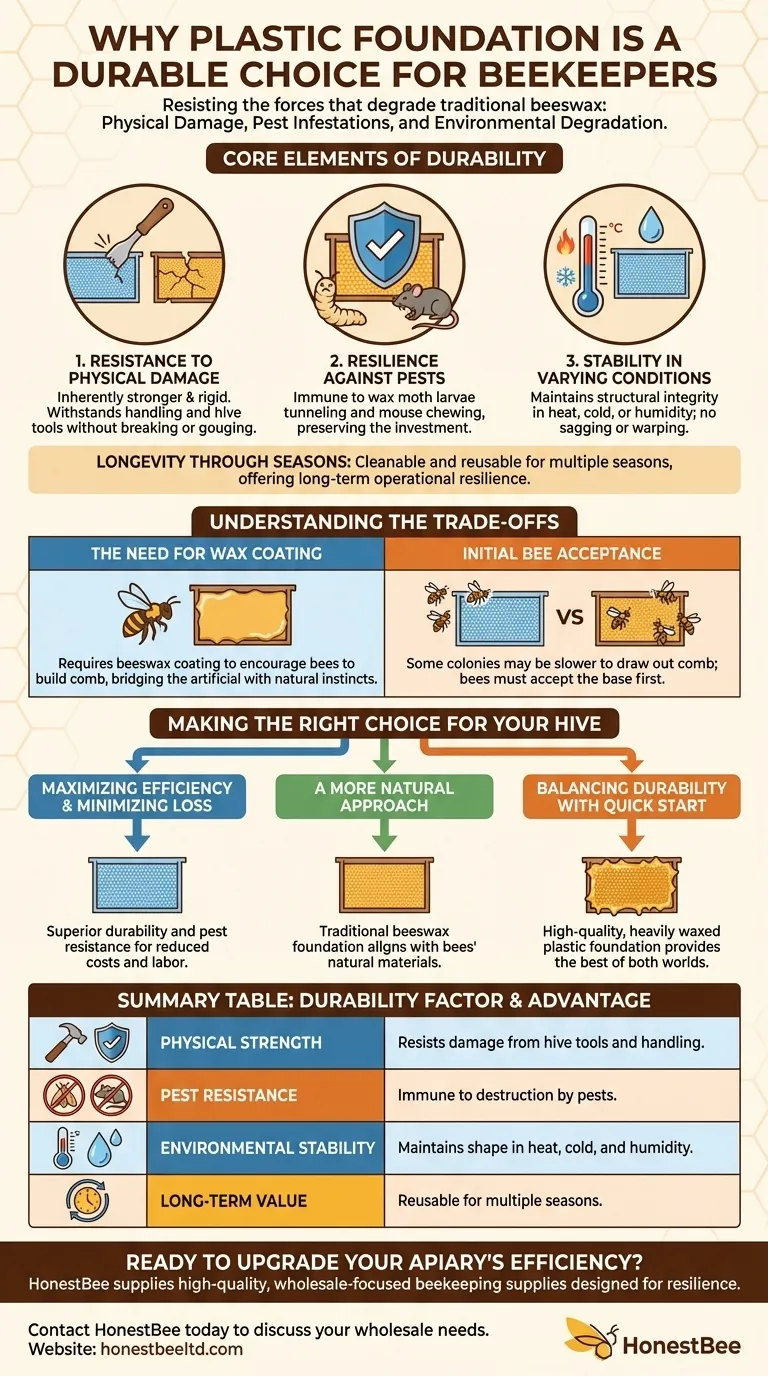In short, plastic foundation is considered durable because it fundamentally resists the three main forces that degrade traditional beeswax foundation. These forces are physical damage from handling and tools, pest infestations from wax moths and mice, and environmental degradation from storage and hive conditions.
The durability of plastic foundation is not just about its physical strength; it represents operational resilience. It is a strategic choice to minimize equipment loss, reduce labor, and ensure hive structure remains stable season after season.

The Core Elements of Plastic Foundation Durability
To understand why plastic foundation is a mainstay, especially in larger beekeeping operations, we need to break down its specific resilience factors compared to its beeswax counterpart.
Resistance to Physical Damage
Plastic foundation is inherently stronger and more rigid than sheets of pure beeswax. This makes it far less prone to damage during installation into frames.
It also withstands the scraping and prying of hive tools during inspections and honey harvesting, processes that can easily gouge or break fragile wax foundation.
Resilience Against Pests
A primary advantage of plastic is its immunity to common apiary pests. Wax moths, whose larvae tunnel through and destroy beeswax comb, cannot consume the plastic.
Similarly, mice that may enter a hive during winter cannot chew through and destroy plastic frames as they can with wax, preserving the beekeeper's investment.
Stability in Varying Conditions
Plastic foundation maintains its structural integrity regardless of temperature or humidity during storage. It will not become brittle in the cold or sag in the heat like beeswax can.
This stability extends into the hive, where the plastic provides a rigid, reliable base that bees can build upon without risk of the foundation warping or collapsing.
Longevity Through Seasons
Because it resists wear and tear from bee activity, pests, and environmental factors, plastic foundation can be cleaned and reused for multiple seasons. This long-term reusability makes it a durable, cost-effective asset over time.
Understanding the Trade-offs
While its durability is a significant advantage, choosing plastic foundation involves acknowledging certain practical considerations. It is not a universally perfect solution.
The Need for a Wax Coating
Bees build comb with wax, and they are naturally drawn to it. To encourage them to build on a plastic base, the foundation sheets almost always require a coating of beeswax.
This coating helps bridge the gap between the inert plastic and the bees' natural instincts, but it is an essential preparatory step for successful adoption.
Initial Bee Acceptance
Even when properly waxed, some colonies may be slower to draw out comb on plastic foundation compared to pure beeswax. The bees must first accept the artificial base before committing their resources to building on it.
Making the Right Choice for Your Hive
The decision between plastic and beeswax foundation ultimately depends on your beekeeping goals and operational scale.
- If your primary focus is maximizing efficiency and minimizing loss: The superior durability and pest resistance of plastic foundation make it the clear choice for reducing costs and labor.
- If your primary focus is a more natural approach: Traditional beeswax foundation may be preferable, as it aligns with the bees' natural building materials, despite its fragility.
- If your primary focus is balancing durability with a quick start: Using a high-quality, heavily waxed plastic foundation provides the best combination of structural integrity and bee acceptance.
Ultimately, understanding the robust nature of plastic foundation empowers you to choose the right tool for the specific demands of your apiary.
Summary Table:
| Durability Factor | Plastic Foundation Advantage |
|---|---|
| Physical Strength | Resists damage from hive tools and handling during installation and inspections. |
| Pest Resistance | Immune to destruction by wax moth larvae and mice. |
| Environmental Stability | Maintains shape and integrity in heat, cold, and humidity during storage and in the hive. |
| Long-Term Value | Can be cleaned and reused for multiple seasons, reducing replacement costs. |
Ready to upgrade your apiary's efficiency and durability?
For commercial apiaries and distributors, durable equipment is the foundation of a profitable operation. HONESTBEE supplies high-quality, wholesale-focused beekeeping supplies designed for resilience and long-term value.
Let us help you build a stronger, more reliable operation. Contact HONESTBEE today to discuss your wholesale needs for durable plastic foundation and other essential equipment.
Visual Guide

Related Products
- Food Grade Plastic bee Foundation for Bee Frames
- Beeswax Foundation Sheets Beehive Foundation for Wholesale
- Electric Beeswax Foundation Machine With Operating Tray and Wax Foundation Roller
- Professional Frame Preparation: The HONESTBEE Electric Wire Embedder
- Professional Dual-End Stainless Steel Hive Tool for Beekeeping
People Also Ask
- What is a plastic foundation sheet? A Durable, Reusable Hive Management Solution
- How do you get bees to draw out plastic foundation? Master the Art of Comb Building
- What additional step can improve the performance of plastic foundation in the hive? Apply a Generous Coat of Beeswax
- How to get bees to draw out plastic foundation? Boost Comb Building with Proven Tactics
- What factors should beekeepers consider when choosing between beeswax and plastic foundation? A Guide to Durability vs. Natural Philosophy



















